TOYOTA MATRIX 2010 E140 / 2.G Service Manual
Manufacturer: TOYOTA, Model Year: 2010, Model line: MATRIX, Model: TOYOTA MATRIX 2010 E140 / 2.GPages: 448, PDF Size: 9.74 MB
Page 41 of 448

41
1
1-3. Adjustable components (seats, mirrors, steering wheel)
Before driving
Rear seats
The seatbacks of the rear seats can be folded down.
Stow the rear outside seat belt
buckles and move the rear
center seat belt buckle as
shown.
Lower the head restraints to
the lowest position.
Fold the seatback down while
pulling the seatback lock
release knob.STEP1
STEP2
STEP3
Page 42 of 448
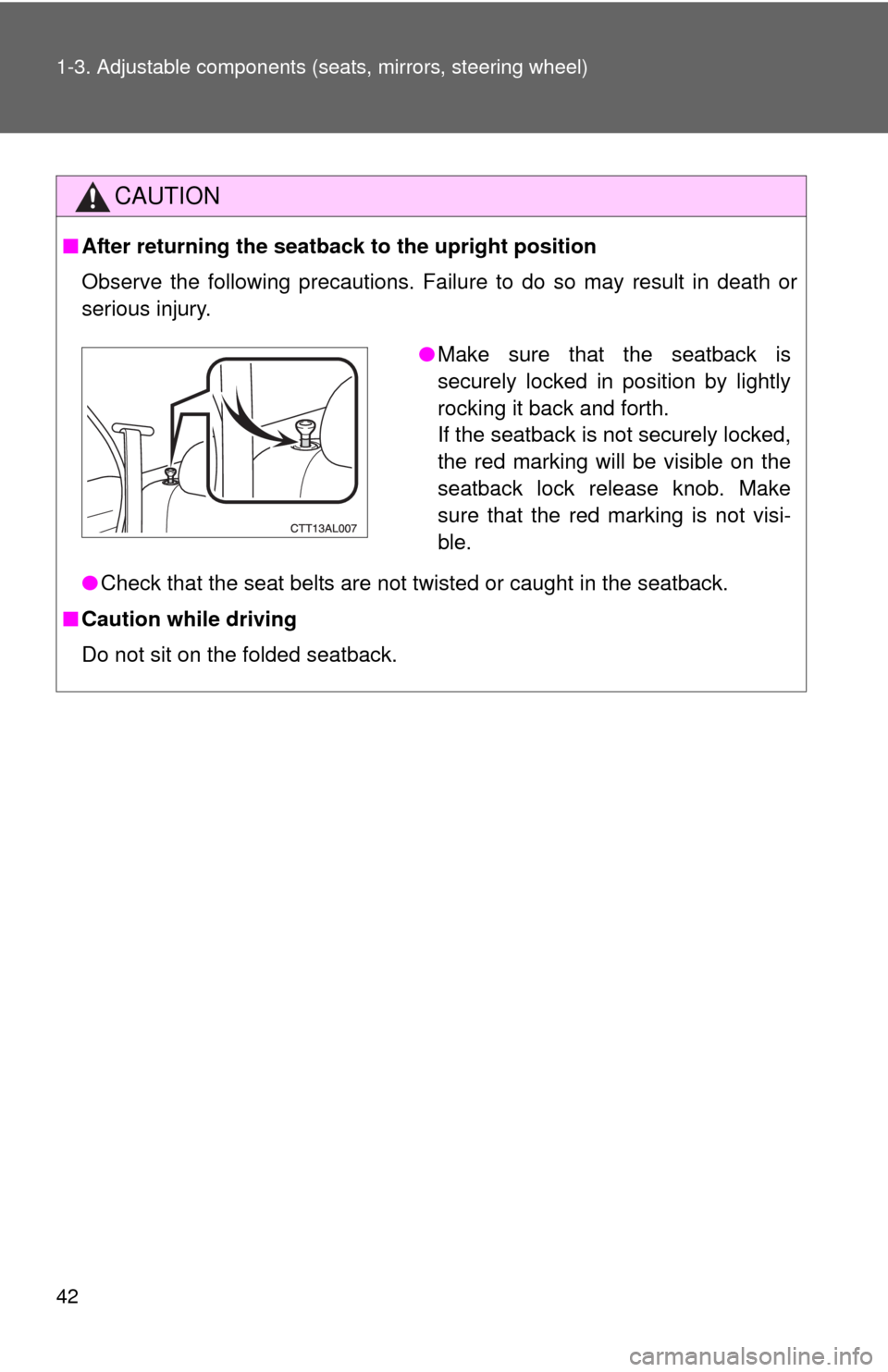
42 1-3. Adjustable components (seats, mirrors, steering wheel)
CAUTION
■After returning the seatback to the upright position
Observe the following precautions. Failure to do so may result in death or
serious injury.
●Check that the seat belts are not twisted or caught in the seatback.
■Caution while driving
Do not sit on the folded seatback.
●Make sure that the seatback is
securely locked in position by lightly
rocking it back and forth.
If the seatback is not securely locked,
the red marking will be visible on the
seatback lock release knob. Make
sure that the red marking is not visi-
ble.
Page 43 of 448

43
1
1-3. Adjustable components (seats, mirrors, steering wheel)
Before driving
Head restraints
■Removing the head restraints
■Installing the head restraints
Head restraints are provided for all seats.
Up
Pull the head restraints up.
Down
Push the head restraint down
while pushing the lock release
button.
Lock
release
button
Pull the head restraint up while pushing
the lock release button.
Align the head restraint with the installa-
tion holes and push it down while press-
ing the lock release button.
Page 44 of 448
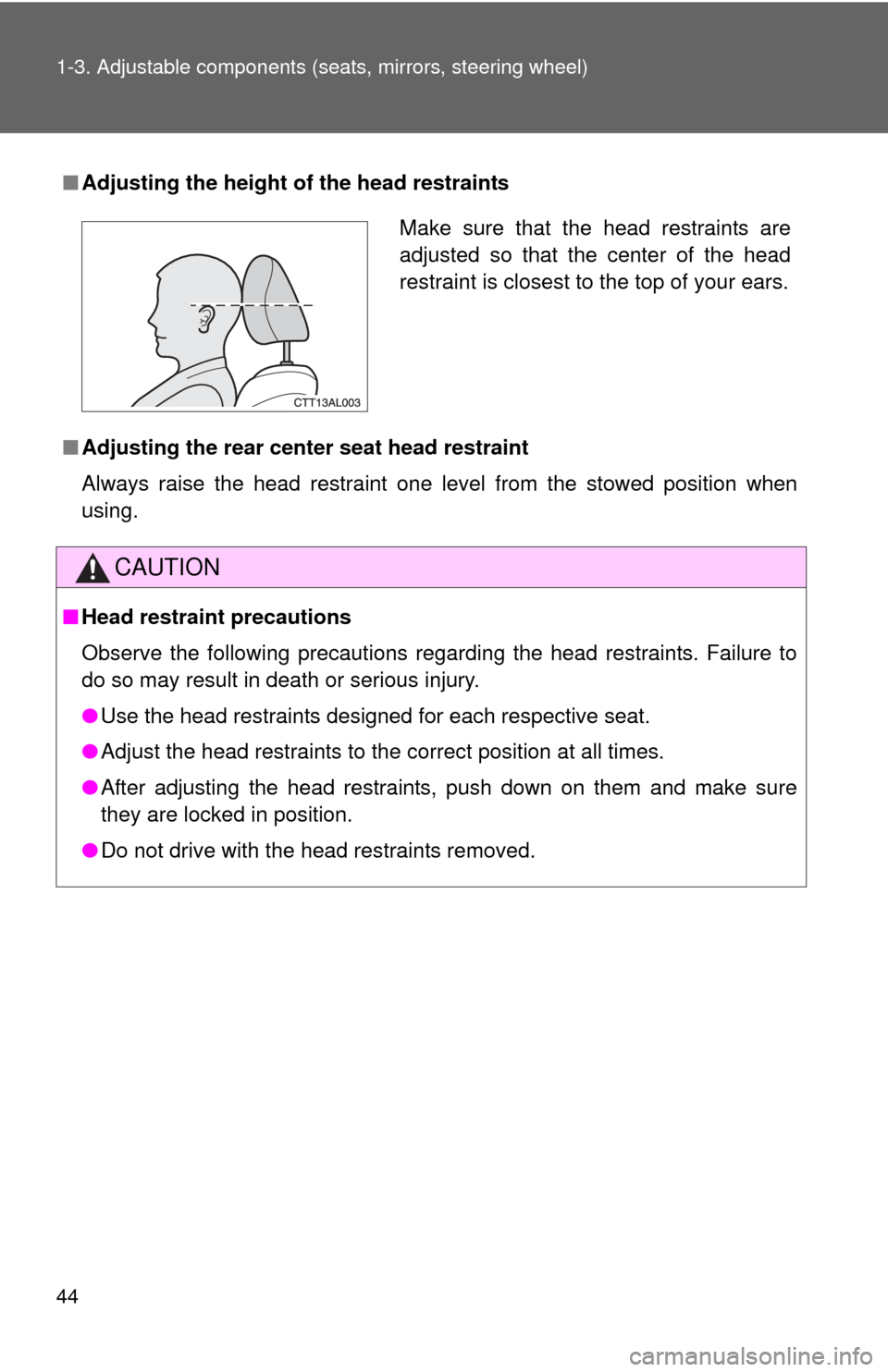
44 1-3. Adjustable components (seats, mirrors, steering wheel)
■Adjusting the height of the head restraints
■Adjusting the rear center seat head restraint
Always raise the head restraint one level from the stowed position when
using.
CAUTION
■Head restraint precautions
Observe the following precautions regarding the head restraints. Failure to
do so may result in death or serious injury.
●Use the head restraints designed for each respective seat.
●Adjust the head restraints to the correct position at all times.
●After adjusting the head restraints, push down on them and make sure
they are locked in position.
●Do not drive with the head restraints removed.
Make sure that the head restraints are
adjusted so that the center of the head
restraint is closest to the top of your ears.
Page 45 of 448
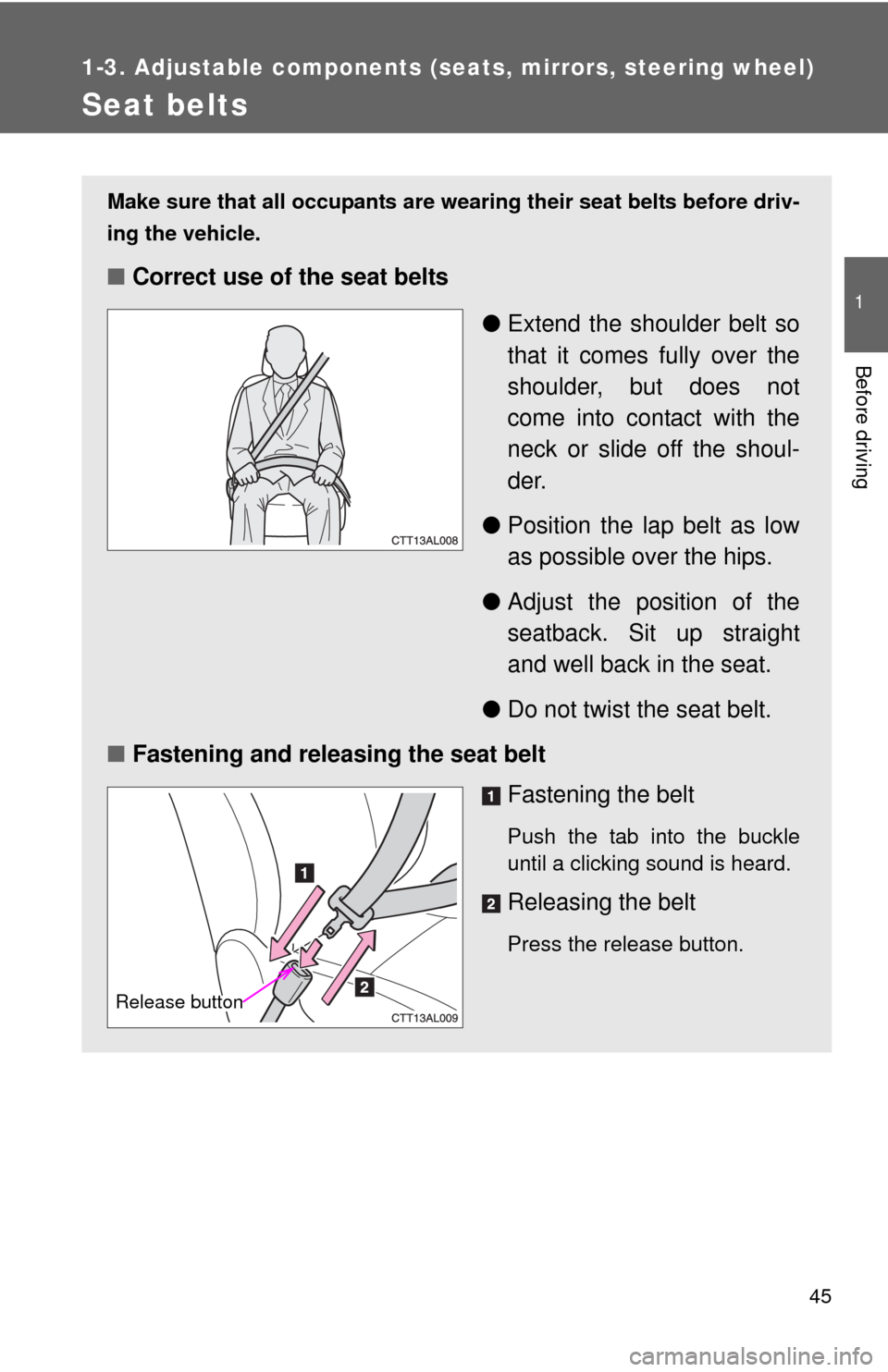
45
1
1-3. Adjustable components (seats, mirrors, steering wheel)
Before driving
Seat belts
Make sure that all occupants are wearing their seat belts before driv-
ing the vehicle.
■Correct use of the seat belts
●Extend the shoulder belt so
that it comes fully over the
shoulder, but does not
come into contact with the
neck or slide off the shoul-
der.
●Position the lap belt as low
as possible over the hips.
●Adjust the position of the
seatback. Sit up straight
and well back in the seat.
●Do not twist the seat belt.
■Fastening and releasing the seat belt
Fastening the belt
Push the tab into the buckle
until a clicking sound is heard.
Releasing the belt
Press the release button.
Release button
Page 46 of 448
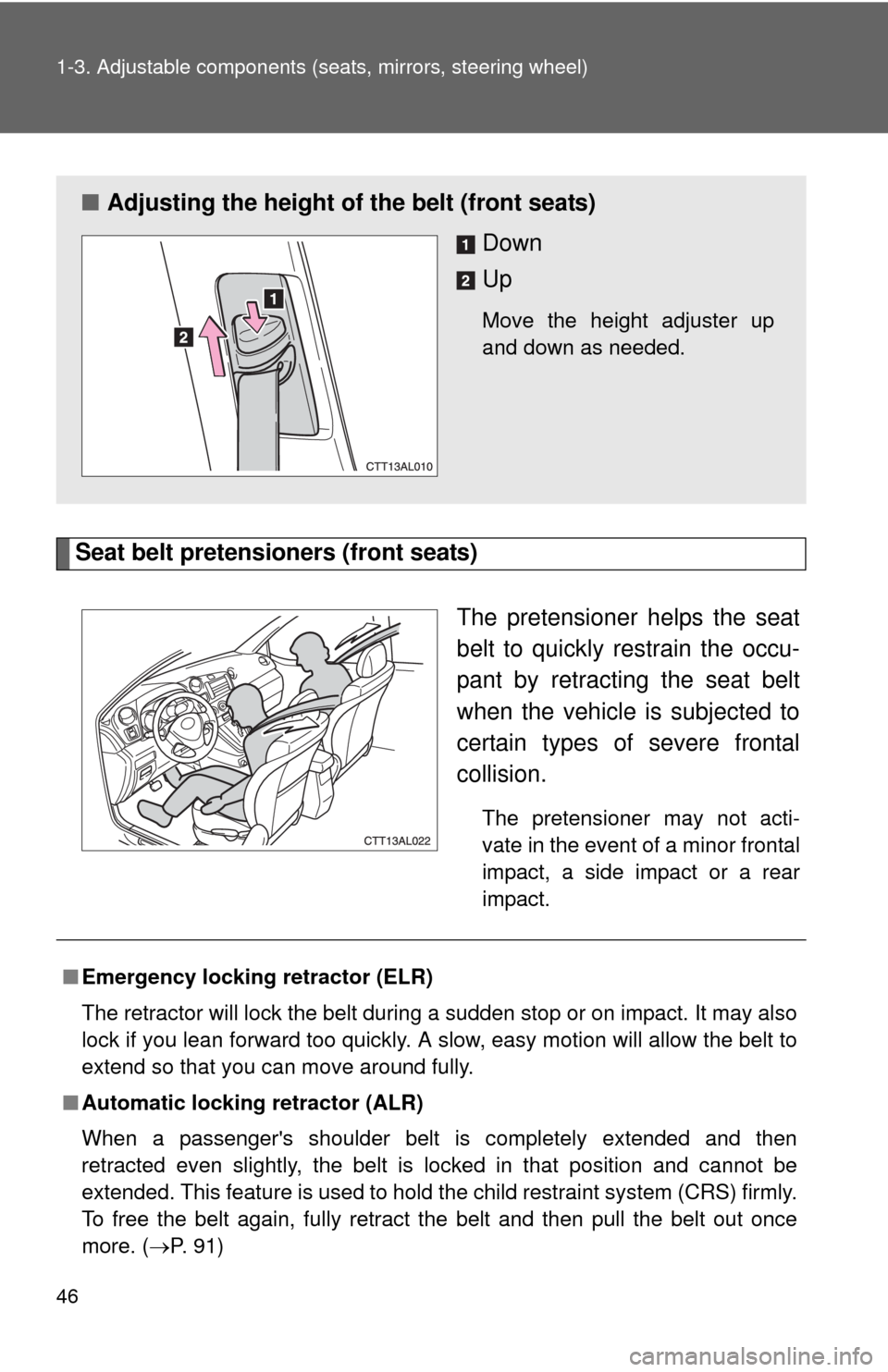
46 1-3. Adjustable components (seats, mirrors, steering wheel)
Seat belt pretensioners (front seats)
The pretensioner helps the seat
belt to quickly restrain the occu-
pant by retracting the seat belt
when the vehicle is subjected to
certain types of severe frontal
collision.
The pretensioner may not acti-
vate in the event of a minor frontal
impact, a side impact or a rear
impact.
■Adjusting the height of the belt (front seats)
Down
Up
Move the height adjuster up
and down as needed.
■Emergency locking retractor (ELR)
The retractor will lock the belt during a sudden stop or on impact. It may also
lock if you lean forward too quickly. A slow, easy motion will allow the belt to
extend so that you can move around fully.
■Automatic locking retractor (ALR)
When a passenger's shoulder belt is completely extended and then
retracted even slightly, the belt is locked in that position and cannot be
extended. This feature is used to hold the child restraint system (CRS) firmly.
To free the belt again, fully retract the belt and then pull the belt out once
more. (P. 91)
Page 47 of 448
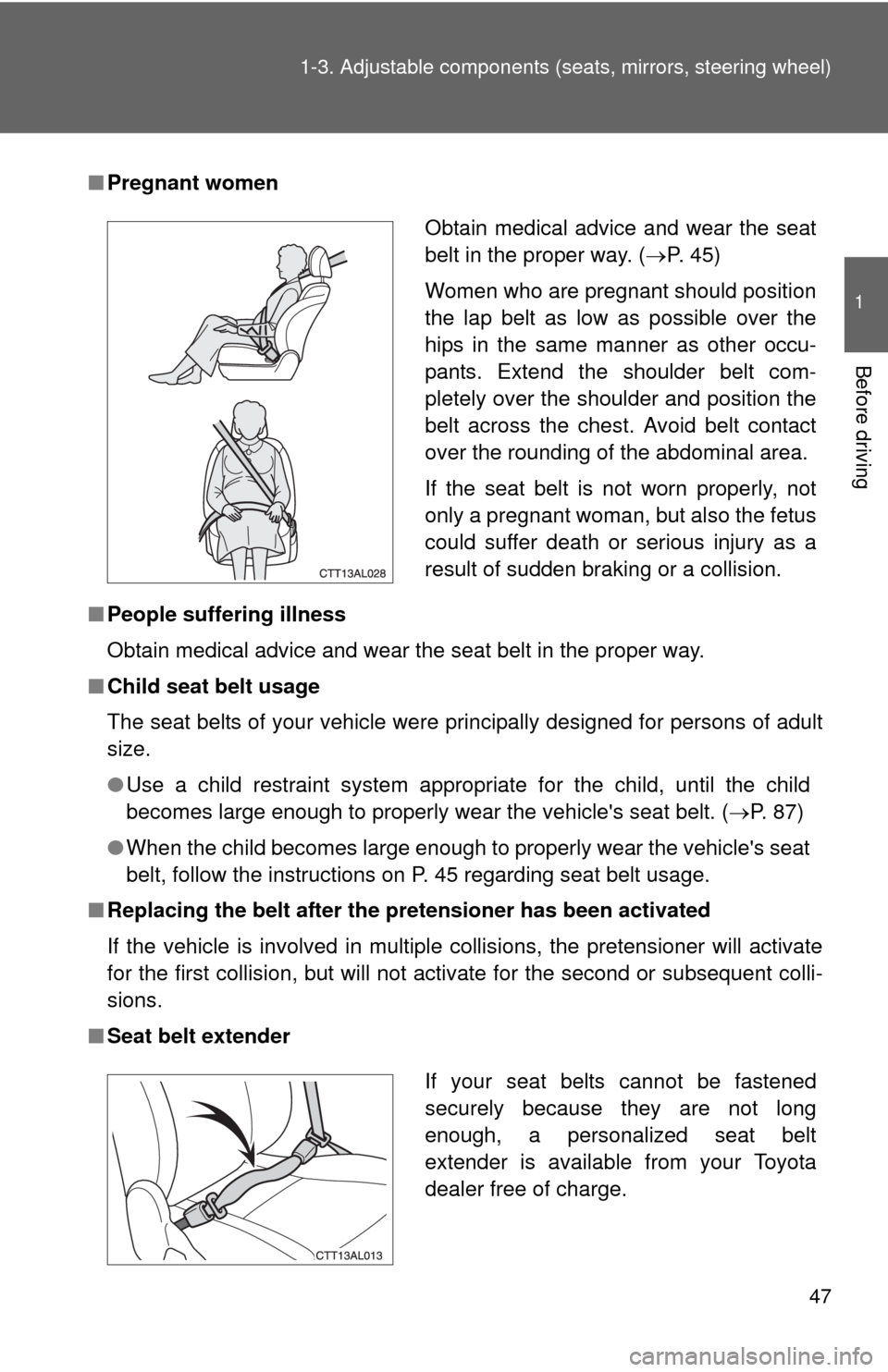
47 1-3. Adjustable components (seats, mirrors, steering wheel)
1
Before driving
■Pregnant women
■People suffering illness
Obtain medical advice and wear the seat belt in the proper way.
■Child seat belt usage
The seat belts of your vehicle were principally designed for persons of adult
size.
●Use a child restraint system appropriate for the child, until the child
becomes large enough to properly wear the vehicle's seat belt. (P. 87)
●When the child becomes large enough to properly wear the vehicle's seat
belt, follow the instructions on P. 45 regarding seat belt usage.
■Replacing the belt after the pretensioner has been activated
If the vehicle is involved in multiple collisions, the pretensioner will activate
for the first collision, but will not activate for the second or subsequent colli-
sions.
■Seat belt extender
Obtain medical advice and wear the seat
belt in the proper way. (P. 45)
Women who are pregnant should position
the lap belt as low as possible over the
hips in the same manner as other occu-
pants. Extend the shoulder belt com-
pletely over the shoulder and position the
belt across the chest. Avoid belt contact
over the rounding of the abdominal area.
If the seat belt is not worn properly, not
only a pregnant woman, but also the fetus
could suffer death or serious injury as a
result of sudden braking or a collision.
If your seat belts cannot be fastened
securely because they are not long
enough, a personalized seat belt
extender is available from your Toyota
dealer free of charge.
Page 48 of 448
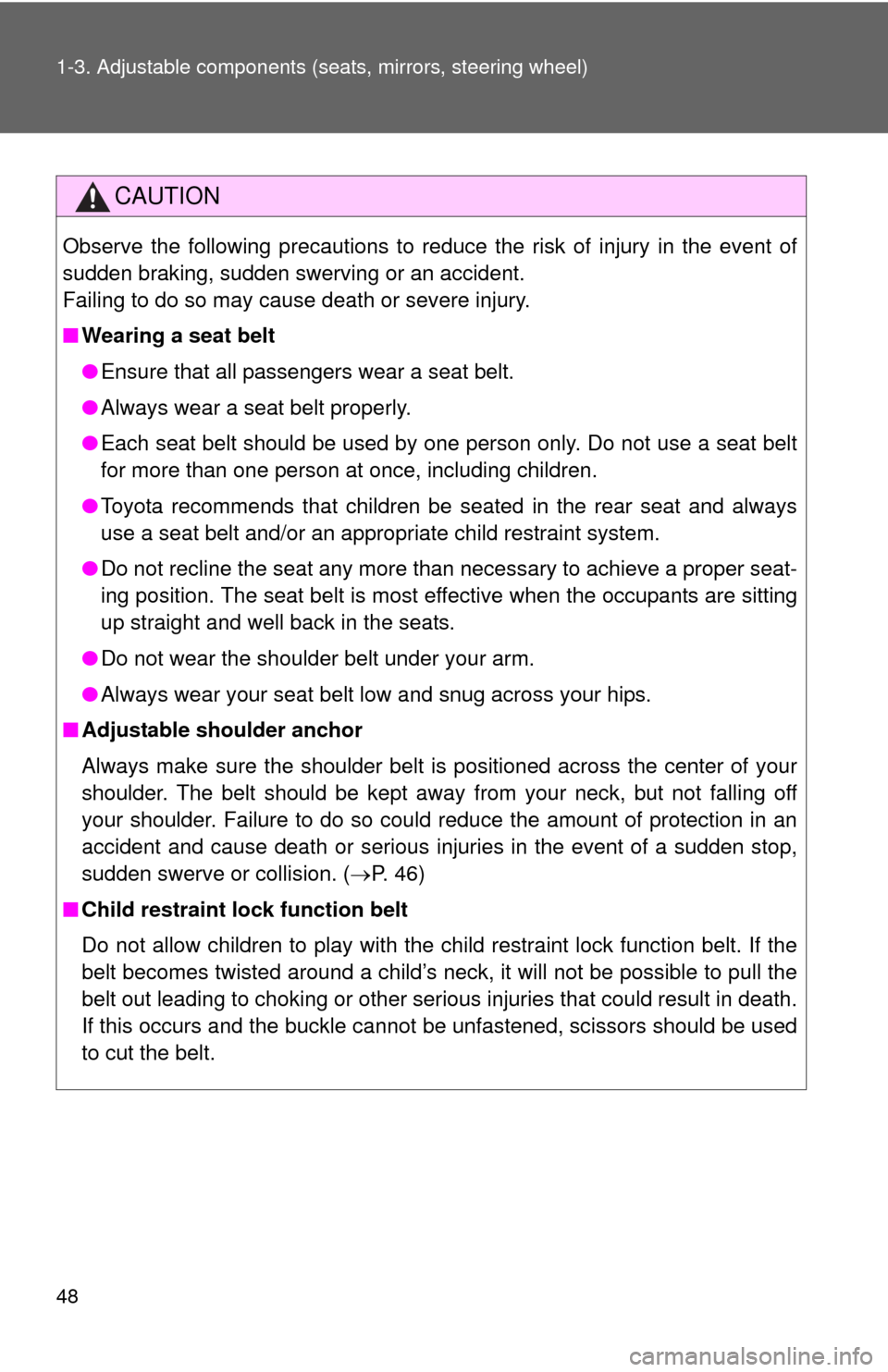
48 1-3. Adjustable components (seats, mirrors, steering wheel)
CAUTION
Observe the following precautions to reduce the risk of injury in the event of
sudden braking, sudden swerving or an accident.
Failing to do so may cause death or severe injury.
■Wearing a seat belt
●Ensure that all passengers wear a seat belt.
●Always wear a seat belt properly.
●Each seat belt should be used by one person only. Do not use a seat belt
for more than one person at once, including children.
●Toyota recommends that children be seated in the rear seat and always
use a seat belt and/or an appropriate child restraint system.
●Do not recline the seat any more than necessary to achieve a proper seat-
ing position. The seat belt is most effective when the occupants are sitting
up straight and well back in the seats.
●Do not wear the shoulder belt under your arm.
●Always wear your seat belt low and snug across your hips.
■Adjustable shoulder anchor
Always make sure the shoulder belt is positioned across the center of your
shoulder. The belt should be kept away from your neck, but not falling off
your shoulder. Failure to do so could reduce the amount of protection in an
accident and cause death or serious injuries in the event of a sudden stop,
sudden swerve or collision. (P. 46)
■Child restraint lock function belt
Do not allow children to play with the child restraint lock function belt. If the
belt becomes twisted around a child’s neck, it will not be possible to pull the
belt out leading to choking or other serious injuries that could result in death.
If this occurs and the buckle cannot be unfastened, scissors should be used
to cut the belt.
Page 49 of 448
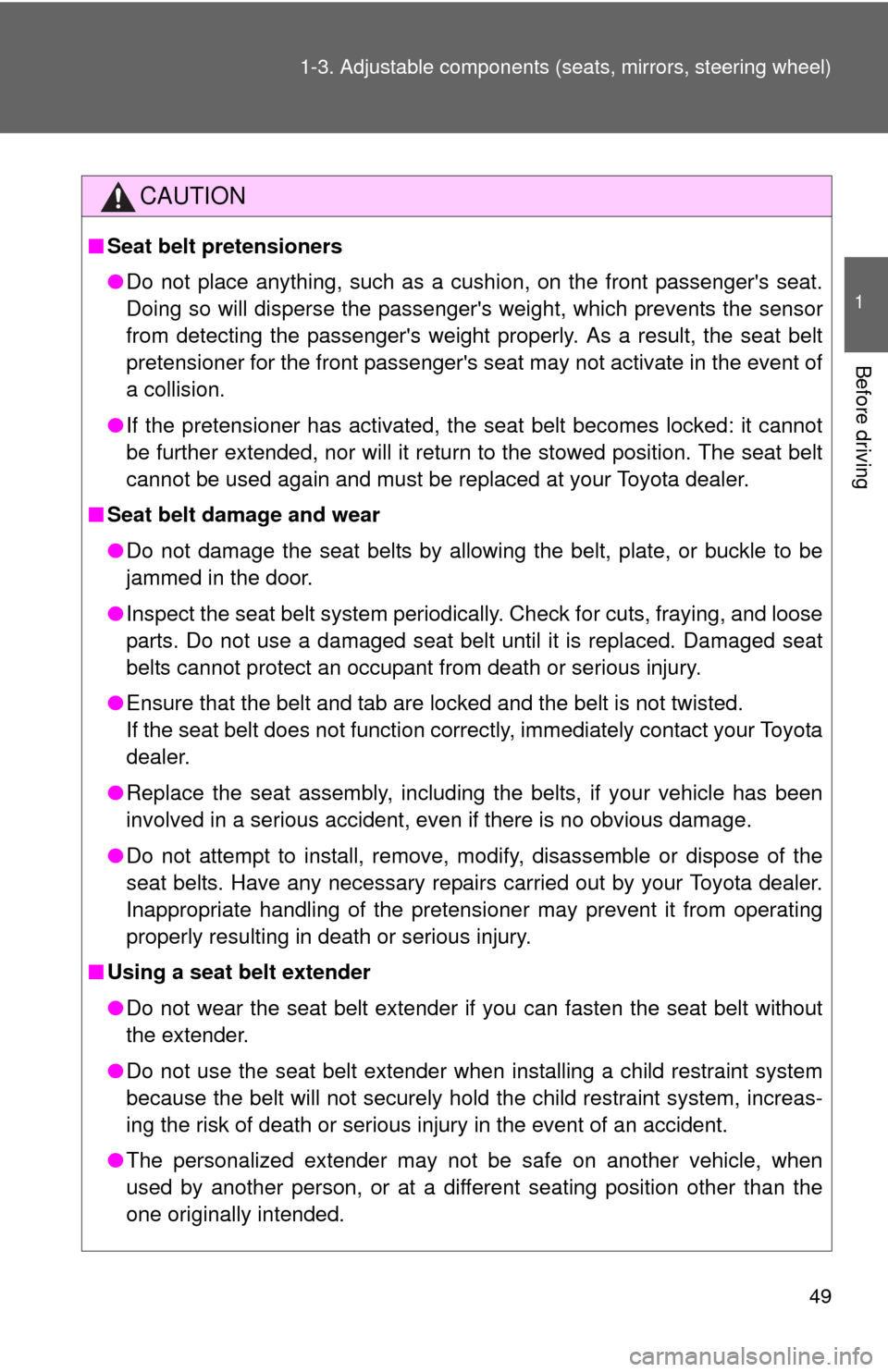
49 1-3. Adjustable components (seats, mirrors, steering wheel)
1
Before driving
CAUTION
■Seat belt pretensioners
●Do not place anything, such as a cushion, on the front passenger's seat.
Doing so will disperse the passenger's weight, which prevents the sensor
from detecting the passenger's weight properly. As a result, the seat belt
pretensioner for the front passenger's seat may not activate in the event of
a collision.
●If the pretensioner has activated, the seat belt becomes locked: it cannot
be further extended, nor will it return to the stowed position. The seat belt
cannot be used again and must be replaced at your Toyota dealer.
■Seat belt damage and wear
●Do not damage the seat belts by allowing the belt, plate, or buckle to be
jammed in the door.
●Inspect the seat belt system periodically. Check for cuts, fraying, and loose
parts. Do not use a damaged seat belt until it is replaced. Damaged seat
belts cannot protect an occupant from death or serious injury.
●Ensure that the belt and tab are locked and the belt is not twisted.
If the seat belt does not function correctly, immediately contact your Toyota
dealer.
●Replace the seat assembly, including the belts, if your vehicle has been
involved in a serious accident, even if there is no obvious damage.
●Do not attempt to install, remove, modify, disassemble or dispose of the
seat belts. Have any necessary repairs carried out by your Toyota dealer.
Inappropriate handling of the pretensioner may prevent it from operating
properly resulting in death or serious injury.
■Using a seat belt extender
●Do not wear the seat belt extender if you can fasten the seat belt without
the extender.
●Do not use the seat belt extender when installing a child restraint system
because the belt will not securely hold the child restraint system, increas-
ing the risk of death or serious injury in the event of an accident.
●The personalized extender may not be safe on another vehicle, when
used by another person, or at a different seating position other than the
one originally intended.
Page 50 of 448
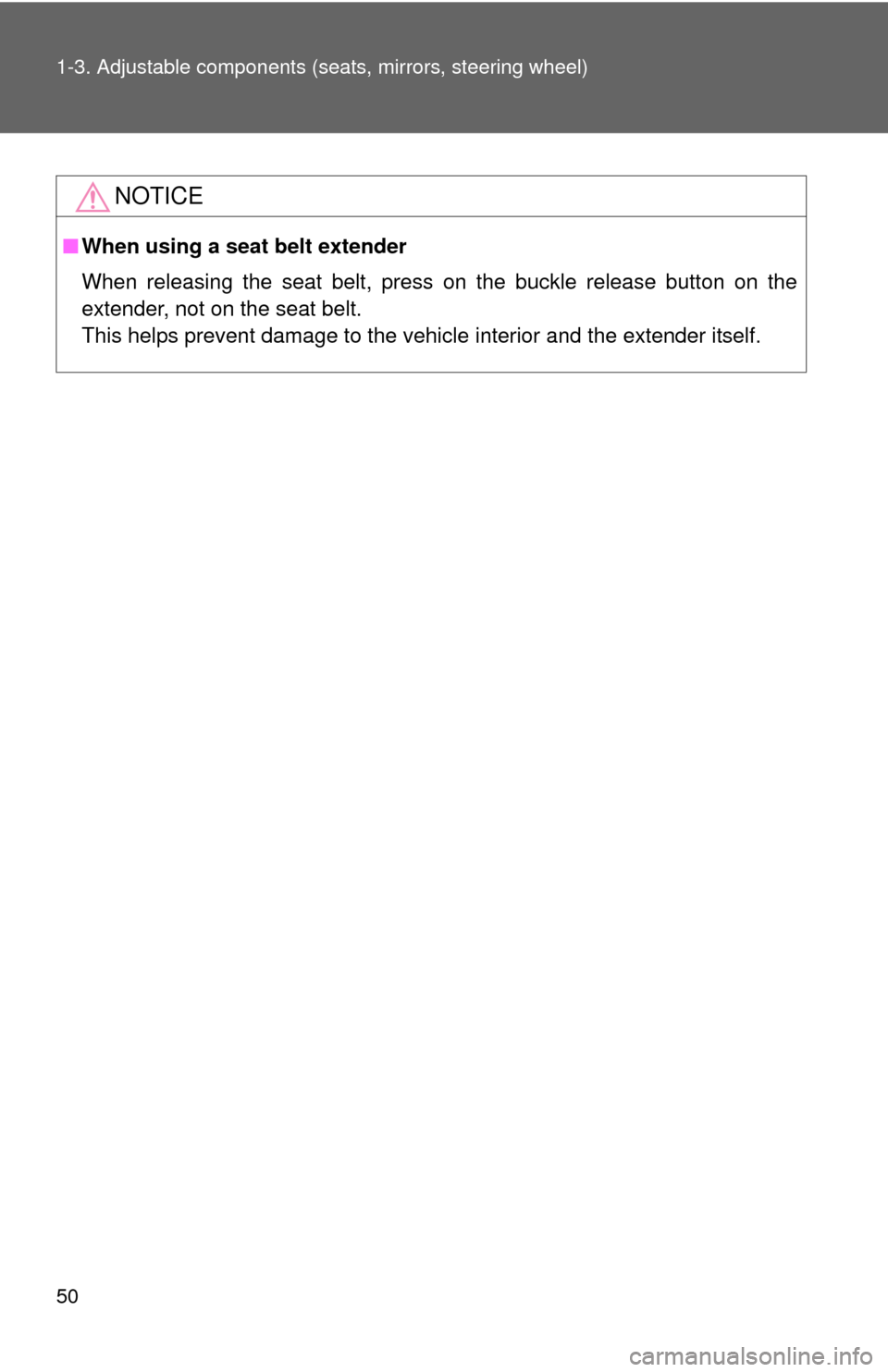
50 1-3. Adjustable components (seats, mirrors, steering wheel)
NOTICE
■When using a seat belt extender
When releasing the seat belt, press on the buckle release button on the
extender, not on the seat belt.
This helps prevent damage to the vehicle interior and the extender itself.